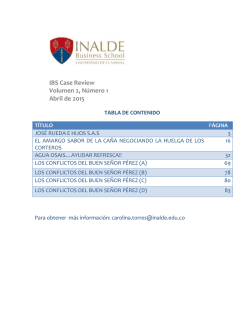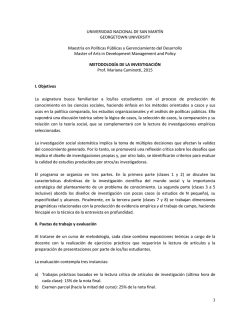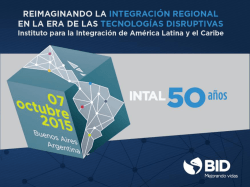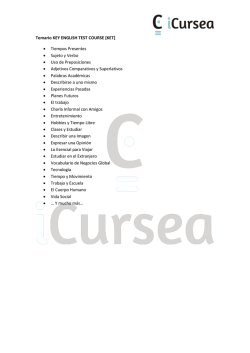
1 of 8 COURSE SYLLABUS 2015-2016 GENERAL
COURSE SYLLABUS 2015-2016 GENERAL INFORMATION Course information Name Code Degree Year Semester ECTS credits Type Department Area Coordinator Instructor Name Department Area Office e-mail Phone Office hours Stochastic optimization MRE-524 Master's Degree in Research in Engineering Systems Modeling (MRE) 1st 2nd (Spring) (even year) 3 Elective Industrial Organization Statistics and Operations Research Andrés Ramos Andrés Ramos Industrial Organization Statistics and Operations Research SM26.D-103 [email protected] 915406150 Arrange an appointment by email 1 of 8 COURSE SYLLABUS 2015-2016 DETAILED INFORMATION Contextualization of the course Contribution to the professional profile of the degree This subject introduces the student in simulation and data analysis techniques for supporting decision-making. Specifically, the contributions of this course to the professional profile are the following: Knowing the application of system simulation in real environments, pros and cons of their use. Designing and developing stochastic optimization models using a simulation language Developing a practical work applied to support decisions in a realistic case study This subject has both theoretical and practical components, based on the exposition and discussion of each topic but also on the application of the simulation and data analysis techniques to realistic case studies. Prerequisites Students willing to take this course should be familiar with linear algebra, and undergraduate-level programming. Previous experience with any modeling language is also desired although not strictly required. 2 of 8 COURSE SYLLABUS 2015-2016 CONTENTS Contents Theory Chapter 1. Introduction 1.1 Generation expansion planning case study. Manufacturing case study. 1.2 Decision tree and scenario tree. 1.3 Two-stage and multistage linear optimization. Hydrothermal coordination problem case study Chapter 2. Linear optimization 2.1. Simplex method. 2.2. Duality. Chapter 3. Decomposition techniques 3.1 3.2 3.3 3.4 3.5 Fixed cost transportation problem. Benders decomposition. Nested Benders decomposition. Dantzig-Wolfe decomposition. Lagrangian relaxation. Additional improvement in decomposition techniques. Stochastic dual dynamic programming. Chapter 4. Scenario tree 4.1 Characterization 4.2 Generation 3 of 8 COURSE SYLLABUS 2015-2016 Competences and Learning Outcomes Competences General Competences Basic Competences CB2. To know how to apply and integrate knowledge, the understanding of it, its scientific basis, and problem-solving capabilities in new and loosely defined environments, including multidisciplinary contexts, both for research and highly-specialized professions. Specific Competences CE9. To know techniques, methods and/or necessary tools to carry out a specific research topic in a sector or particular technological context. Optional Competences CO3. To understand the statistical concepts associated to the representation of random parameters. CO4. To understand the mathematical principles of linear optimization, sensibility analysis and duality and the ability to use them. Learning outcomes At the end of the course the student must have the following competences: RA1. Understand the concepts of stochastic optimization RA2. Become familiar within the several topics where stochastic optimization can be applied RA3. Know how to build an optimization model efficiently RA4. Achieve mathematical rigorousness RA5. Understand the mathematical techniques used RA6. State and solve mockup problems RA7. Analyze the solutions RA8. Be prepared to extend their knowledge RA9. Become familiar with an algebraic language used professionally 4 of 8 COURSE SYLLABUS 2015-2016 TEACHING METHODOLOGY General methodological aspects The objective is improving the learning and incentivizing the autonomous and critical thinking of the students. For that purpose the following teaching resources are used. The teaching resources mentioned require the active participation of the student. It is indispensable that the class activity would be complemented with the personal work of the student and, coherently, it will be taken into account to assess the student performance. In-class activities Competences Master lectures (20h): presentation of the contents of the subject. Public presentation of the assignments (10h) Out-of-class activities CB1, CB2, CE2 CE3 Competences Personal work of the student (30h): study of the contents provided in the master lectures. It requires a deep and critical analysis about modeling aspects of the optimization problems allowing different perspectives and incentivizing creativity and critical thought of the student. CB1, CE2 Assignments (30h): improve knowledge of the techniques presented. CB2, CE3 5 of 8 COURSE SYLLABUS 2015-2016 ASSESSMENT AND GRADING CRITERIA Assessment activities Grading criteria Weight Case study Practical case statement Model development Theoretical contribution Solution analysis Written communication skill Teamwork (if done in a team) 80% Communication skill Oral presentation of the case study 15% Classroom participation Attendance and active participation in class 5% GRADING AND COURSE RULES Grading Regular assessment Case study will account for the 100%, of which: Written report: 80% Oral presentation: 15% Participation: 5% In case that the written report mark is equal or lower than 3.5, the final grade will be the written report mark. Otherwise, the final grade is computed weighting the different marks as the previously shown percentages. In order to pass the course, the final grade should be greater or equal to 5.0. Retakes The final grade is computed based only in a new written report about the same or different case study. In order to pass the course, the final grade should be greater or equal to 5.0. Course rules Class attendance is mandatory according to Article 93 of the General Regulations (Reglamento General) of Comillas Pontifical University and Article 6 of the Academic Rules (Normas Académicas) of the ICAI School of Engineering. Not complying with this requirement may have the following consequences: - Students who fail to attend more than 15% of the lectures may be denied the right to take the final exam during the regular assessment period. Students who commit an irregularity in any graded activity will receive a mark of zero in the activity and disciplinary procedure will follow (cf. Article 168 of the General Regulations (Reglamento General) of Comillas Pontifical University). WORK PLAN AND SCHEDULE1 1 A detailed work plan of the subject can be found in the course summary sheet (see following page). Nevertheless, this schedule is tentative and may vary to accommodate the pace of the class. 6 of 8 COURSE SYLLABUS 2015-2016 In and out-of-class activities Date/Periodicity Case study sessions Review and self-study of the concepts covered in the lectures Problem-solving Case study report writing Case study oral presentation Deadline Every week After each lesson Weekly December During the course and, in particular, the last part of the course STUDENT WORK-TIME SUMMARY IN-CLASS HOURS Lectures 15 Problem-solving 5 Case sessions 5 Self-study Problem preparation 25 5 Practices 5 OUT-OF-CLASS HOURS Case preparation and evaluation 20 ECTS credits: Final report 10 3 (90 hours) BIBLIOGRAPHY Basic bibliography Notes prepared by the lecturer (available in Moodle). Birge, J.R. and Louveaux, F. (2011) Introduction to Stochastic Programming. Springer-Verlag. Ramos, A., A. Alonso-Ayuso, G. Pérez (eds.) (2008) Optimización bajo Incertidumbre Universidad Pontificia Comillas Complementary bibliography 7 of 8 COURSE SYLLABUS 2015-2016 IN-CLASS ACTIVITIES Week h/w LECTURE & PROBLEM SOLVING LAB LEARNING OUTCOMES OUT-OF-CLASS ACTIVITIES ASSESMENT LAB PREPARATION AND REPORTING h/w SELF-STUDY OTHER ACTIVITIES Learning Outcomes 1 2 Course presentation and topic 1. Introduction to stochastic optimization. Generation expansion planning study Problem solving case. Production case study. Decision and scenario tree. 3 Review, self-study and problemsolving (2h) Problem preparation (1 h) RA1, RA9 RA1. Understand where to use and concepts of stochastic optimization 2 2 Two‐stage and multistage linear Problem solving optimization. Application to hydrothermal scheduling problem. 4 Review, self-study and problemsolving (2h) Problem preparation (2 h) RA2, RA3, RA4 RA2. Become familiar within the several topics where stochastic optimization can be applied 3 2 Application case: stochastic unit commitment Problem solving 5 Review, self-study and problemsolving (3h) Problem preparation (2 h) RA2, RA3, RA4 RA3. Know how to build an optimization model efficiently 4 2 Application case: medium-term hydrothermal scheduling Case study and practice 1 Review, self-study and case-solving (1h) RA5, RA6, RA7 RA4. Achieve mathematical rigorousness 5 2 Decomposition techniques. Case study and practice 2 Review, self-study and case-solving (2h) RA5, RA6, RA7 RA5. Understand the mathematical techniques used 6 2 Linear optimization. Simplex method. Duality. Case study and practice 5 Review, self-study and case-solving (1h) RA5, RA6, RA7 RA6. State and solve mockup problems 7 2 Benders decomposition. Case study and practice 2 Review, self-study and case-solving (2h) RA5, RA6, RA7 RA7. Analyze the solutions 8 2 Fixed cost transportation problem. Case study and practice 5 Review, self-study and case-solving (1h) RA5, RA6, RA7 RA8. Be prepared to extend their knowledge 9 2 Small examples of Benders decomposition. Case study and practice 2 Review, self-study and case-solving (2h) RA5, RA6, RA7 RA9. Become familiar with an algebraic language used professionally 10 2 Nested Benders decomposition. Case study and practice 5 Review, self-study and case-solving (1h) 11 2 Danztig-Wolfe decomposition. Case study and practice 2 Review, self-study and case-solving (2h) 12 2 Lagrangian relaxation. Fixed cost transportation problem. Case study and practice 5 Review, self-study and case-solving (1h) Work preparation (4h) RA5, RA6, RA7 13 2 Scenario tree. Case study and practice 7 Review, self-study and case-solving (2h) Final report (5) RA5, RA6, RA7, RA8 14 2 Decomposition in two-stage and multistage stochastic planning. Case study and practice 5 Review, self-study and case-solving (1h) Work preparation (4h) RA5, RA6, RA7 15 2 Improvements in decomposition techniques. Simulation in stochastic programming Case study and practice 7 Review, self-study and case-solving (2h) Final report (5) RA5, RA6, RA7, RA8 Presentation assessment Presentation assessment Presentation assessment Presentation assessment Presentation assessment Work preparation (4h) Work preparation (4h) Work preparation (4h) RA5, RA6, RA7 RA5, RA6, RA7 8 of 8 FICHA TÉCNICA DE LA ASIGNATURA Datos de la asignatura Nombre Código Titulación Curso Cuatrimestre Créditos ECTS Carácter Departamento Área Coordinador Optimización Estocástica MRE-524 Master's Degree in Research in Engineering Systems Modeling (MRE) Primero 2º (año par) 3 Optativa Organización Industrial Estadística e Investigación Operativa Andrés Ramos Datos del profesorado Profesor Nombre Departamento Área Despacho e-mail Teléfono Horario de Tutorías Andrés Ramos Organización Industrial Estadística e Investigación Operativa SM26.D-103 [email protected] 915406150 Previa petición por correo electrónico DATOS ESPECÍFICOS DE LA ASIGNATURA Contextualización de la asignatura Aportación al perfil profesional de la titulación La asignatura introduce al estudiante en las técnicas de optimización determinista para la toma de decisiones. Específicamente las contribuciones del curso al perfil profesional son las siguientes: Conocimiento de la aplicación de la optimización de sistemas en entornos reales, pros y contras de su uso Diseño y desarrollo de modelos de optimización utilizando un lenguaje algebraico Desarrollo de una aplicación práctica de toma de decisiones en un caso realista Esta asignatura tiene componentes teóricos y prácticos, basados en la exposición y presentación de cada tema así como en la aplicación de técnicas de optimización determinista a casos reales. Prerrequisitos Los estudiantes deben conocer algebra lineal y programación a nivel de grado. Además, se valorará la experiencia previa con lenguajes algebraicos, aunque no es imprescindible. 1 Competencias - Objetivos Competencias Básicas CB2. Saber aplicar e integrar sus conocimientos, la comprensión de estos, su fundamentación científica y sus capacidades de resolución de problemas en entornos nuevos y definidos de forma imprecisa, incluyendo contextos de carácter multidisciplinar tanto investigadores como profesionales altamente especializados.. Competencias Específicas CE9. Conocer las técnicas, métodos y/o herramientas necesarias para llevar a cabo una investigación específica en un sector o contexto tecnológico específico. Competencias Opcionales CO3. Entender los conceptos estadísticos asociados a la representación de parámetros aleatorios. CO4. Entender los principios matemáticos de optimización lineal, análisis de sensibilidad y duales y la capacidad para utilizarlos. Resultados de aprendizaje Al final del curso el alumno debe adquirir los siguientes resultados de aprendizaje: RA1. Entender los conceptos de optimización estocástica RA2. Comprender los entornos donde se puede utilizar optimización determinista RA3. Saber cómo construir un modelo de optimización eficientemente RA4. Conseguir rigurosidad matemática RA5. Entender las técnicas matemáticas utilizadas RA6. Formular y resolver problemas pequeños RA7. Analizar las soluciones RA8. Estar preparado para extender este conocimiento RA9. Estar familiarizado con un lenguaje algebraico de uso profesional 2 BLOQUES TEMÁTICOS Y CONTENIDOS Contenidos – Bloques Temáticos BLOQUE 1: Modelado Los siguientes contenidos estarán enfocados a los sistemas de información a la dirección, la organización industrial, sistemas productivos y logística y sistemas de gestión de calidad. Tema 1. INTRODUCCIÓN 1.1 Caso de estudio de planificación de la expansión de la generación. Caso de estudio de producción. 1.2 Árbol de decisión y árbol de escenarios. 1.3 Optimización lineal bietapa y multietapa. Caso de estudio de modelo de coordinación hidrotérmica. Tema 2. OPTIMIZACIÓN LINEAL 2.1. Método simplex. 2.2. Dualidad Tema 3. TÉCNICAS DE DESCOMPOSICIÓN 3.1 Problema de transporte de coste fijo. 3.2 Descomposición de Benders. Descomposición anidada de Benders. 3.3 Descomposición de Dantzig-Wolfe. Relajación lagrangiana. 3.4 Mejoras adicionales en técnicas de descomposición. 3.5 Programación dinámica dual estocástica Tema 4. ÁRBOL DE ESCENARIOS 4.1 Caracterización 4.2 Generación 3 METODOLOGÍA DOCENTE Aspectos metodológicos generales El objetivo es mejorar el aprendizaje e incentive el pensamiento crítico y autónomo de los estudiantes. Para ello se utilizan los siguientes recursos. Los recursos de docencia mencionados requieren la participación activa del estudiante. Es indispensable que la actividad de clase sea complementada con el trabajo personal del estudiante y, coherentemente, será tenido en cuenta en la evaluación de su rendimiento. Actividades presenciales Sesiones teóricas (20h): presentaciones de los contenidos de la asignatura. Presentación pública de los trabajos (10h) Actividades no presenciales Trabajo personal del estudiante (30h): estudio de los contenidos proporcionados en las sesiones presenciales. Requiere de un análisis crítico y profundo sobre aspectos de modelado en problemas de optimización permitiendo diferentes perspectivas e incentivando la creatividad y el pensamiento crítico del estudiante. Trabajos (30h): mejoran el conocimiento de las técnicas presentadas. CB1, CB2, CE2 CE3 CB1, CE2 CB2, CE3 RESUMEN HORAS DE TRABAJO DEL ALUMNO HORAS PRESENCIALES Lección magistral Resolución de problemas Casos de estudio Prácticas 15 5 5 5 HORAS NO PRESENCIALES Trabajo autónomo sobre contenidos teóricos Trabajo autónomo sobre contenidos prácticos 25 5 Realización de trabajos colaborativos 20 CRÉDITOS ECTS: Prácticas 10 3 (90 horas) EVALUACIÓN Y CRITERIOS DE CALIFICACIÓN Actividades de evaluación Caso de estudio Criterios de evaluación - Presentación oral - Participación en clase - Definición de un caso práctico Desarrollo de un modelo Contribución teórica Análisis de la solución Escritura del trabajo Trabajo en equipo (si se hace así) Presentación oral del caso de estudio Asistencia presencial y participación activa en clase CALIFICACIONES Calificaciones Convocatoria ordinaria El caso de estudio contará el 100%, de los cuales: Informe escrito: 80% 4 PESO 80 % 15% 5% Presentación oral: 15% Participación: 5% En caso de que la nota del informe escrito sea menor o igual que 3.5, la nota final será ésta. Si no, la nota final se calculará pesando las notas previas de acuerdo a dichos porcentajes. Para aprobar el curso la nota final debe ser mayor o igual que 5.0. Convocatoria extraordinaria La nota final se calcula basada únicamente en un nuevo informe escrito sobre el mismo tema u otro diferente. Para aprobar el curso la nota final debe ser mayor o igual que 5.0. Normas académicas La asistencia a clase es obligartoria de acurdo con el Artículo 93 del Reglamento General de la Universidad Pontificia Comillas y el Artículo 6 de las Normas Académicas de la Escuela Técnicas Superior de Ingeniería. No cumplir con dicho requisito puede tener las siguientes consecuencias: A los estudiantes que no asistan a más del 15 % de las clases se les puede denegar el derecho al examen final en el periodo de evaluación ordinario Los estudiantes que cometan una irregularidad en cualquier actividad académica recibirán una nota de cero en dicha actividad y se les abrirá un proceso disciplinario (cf. Artículo 168 del Reglamento General de la Universidad Pontificia Comillas) PLAN DE TRABAJO Y CRONOGRAMA1 Actividades No presenciales Sesiones de casos de estudio Revisión y estudio individual de los conceptos cubiertos en las clases Resolución de problemas Escritura del informe del caso de estudio Presentación oral del caso de estudio Fecha de realización Cada semana Fecha de entrega Después de cada clase Semanalmente Diciembre Durante el curso y, en particular, en la última parte del mismo BIBLIOGRAFÍA Y RECURSOS Bibliografía Básica Apuntes preparados por el profesor (disponibles en Moodle). Birge, J.R. and Louveaux, F. (2011) Introduction to Stochastic Programming. SpringerVerlag. Ramos, A., A. Alonso-Ayuso, G. Pérez (eds.) (2008) Optimización bajo Incertidumbre Universidad Pontificia Comillas Bibliografía Complemetaria 1 En la ficha resumen se encuentra una planificación detallada de la asignatura. Esta planificación tiene un carácter orientativo y las fechas podrán irse adaptando de forma dinámica a medida que avance el curso. 5 ACTIVIDADES PRESENCIALES Semana h/s CLASES Y RESOLUCIÓN DE PROBLEMAS Presentación del curso y tema 1. Introducción a la optimización estocástica. Caso de estudio de planificación de la expansión de la generación. Caso de estudio de producción. Árbol de decisión y árbol de escenarios. LAB ACTIVIDADES NO PRESENCIALES TRABAJO h/s ESTUDIO INDIVIDUAL LAB PREPARATION AND REPORTING OTRAS ACTIVIDADES RESULTADOS DE APRENDIZAJE Resultados de aprendizaje Resolución de problemas 3 Revisión, estudio individual y resolución de problemas (2h) Prepración de problemas (1 h) RA1, RA9 RA1. Entender los conceptos de optimización determinista Optimización lineal bietapa y multietapa. Resolución de problemas 4 Revisión, estudio individual y resolución de problemas (2h) Prepración de problemas (2 h) RA2, RA3, RA4 RA2. Comprender los entornos donde se puede utilizar optimización determinista 2 Caso de aplicación. Programación diaria estocástica Resolución de problemas 5 Revisión, estudio individual y resolución de problemas (3h) Prepración de problemas (2 h) RA2, RA3, RA4 RA3. Saber cómo construir un modelo de optimización eficientemente 4 2 Caso de estudio: modelo de coordinación hidrotérmica. Caso de estudio y práctica 1 Revisión, estudio individual y resolución de problemas (1h) RA5, RA6, RA7 RA4. Conseguir rigurosidad matemática 5 2 Técnicas de descomposición. Caso de estudio y práctica 2 Revisión, estudio individual y resolución de problemas (2h) RA5, RA6, RA7 RA5. Entender las técnicas matemáticas utilizadas 6 2 Optimización lineal. Método simplex. Dualidad Caso de estudio y práctica 5 Revisión, estudio individual y resolución de problemas (1h) RA5, RA6, RA7 RA6. Formular y resolver problemas pequeños 7 2 Descomposición de Benders. Caso de estudio y práctica 2 Revisión, estudio individual y resolución de problemas (2h) RA5, RA6, RA7 RA7. Analizar las soluciones 8 2 Problema de transporte de coste fijo. Caso de estudio y práctica 5 Revisión, estudio individual y resolución de problemas (1h) RA5, RA6, RA7 RA8. Estar preparado para extender este conocimiento 9 2 Pequeños ejemplos de descomposición de Benders. Caso de estudio y práctica 2 Revisión, estudio individual y resolución de problemas (2h) RA5, RA6, RA7 RA9. Estar familiarizado con un lenguaje algebraico de uso profesional 10 2 Descomposición anidada de Benders. Caso de estudio y práctica 5 Revisión, estudio individual y resolución de problemas (1h) 11 2 Descomposición de Dantzig-Wolfe. Caso de estudio y práctica 2 Revisión, estudio individual y resolución de problemas (2h) 12 2 Relajación lagrangiana. Problema de transporte de coste fijo. Caso de estudio y práctica 5 Revisión, estudio individual y resolución de problemas (1h) Preparación del trabajo (4h) 13 2 Árbol de escenarios. Caso de estudio y práctica 7 Revisión, estudio individual y resolución de problemas (2h) Informe final (5) 14 2 Descomposición en planificación estocástica bietapa y multietapa Caso de estudio y práctica 5 Revisión, estudio individual y resolución de problemas (1h) Preparación del trabajo (4h) 15 2 Mejoras adicionales en técnicas de descomposición. Simulación en optimización estocástica Caso de estudio y práctica 7 Revisión, estudio individual y resolución de problemas (2h) Informe final (5) 1 2 2 2 3 Presentación del trabajo Presentación del trabajo Presentación del trabajo Presentación del trabajo Presentación del trabajo Preparación del trabajo (4h) Preparación del trabajo (4h) Preparación del trabajo (4h) RA5, RA6, RA7 RA5, RA6, RA7 7 RA5, RA6, RA7 RA5, RA6, RA7, RA8 RA5, RA6, RA7 RA5, RA6, RA7, RA8
© Copyright 2026





